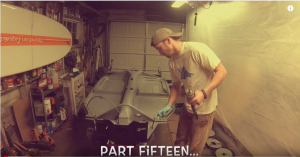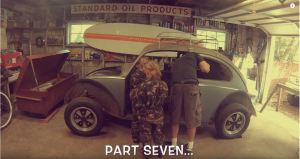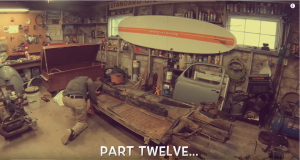Tools Needed:
There are a few tools needed for this step. Along with these tools, having a set of sawhorses is definitely helpful when working on the body panels.
- Welder – get a decent welder or borrow one from a friend (for welding in the jack supports). I have a simple flux core wire feed welder that I use for all the sheet metal work – it’s not ideal, but gets the job done. It would be nice to have something better, but they get expensive quick. Of course you’ll also probably want a welding helmet, some dikes/wire cutters, and welding hammer and gloves too. (see resources page)
- Angle Grinder with attachments – an angle grinder is one of the tools I use the most – whether using a cutting blade, wire brush wheel, flap disc, or grinding wheel – you can’t get by without one.. or at least I wouldn’t want to try getting by without one. I have a couple cheap-o grinders that I use all the time. Stock up with a few wire wheels, cutting wheels, and flap discs because you’ll use them. For this step, I used the grinding wheel to grind down the welds. (see resources page)
- Hammer/dolly – with the body work, the idea in the beginning is to get the parts as dent free as possible so we’re not trying to slap inches of body filler on them just to make them pretty. That doesn’t last long. I would recommend investing in a decent hammer/dolly set. You don’t need anything fancy – unless you have extra money to blow. You can find a cheap set at Harbor Freight, or spend more on a higher quality set. (see resources page)
- Body work tools – having a mixing pallet for the body filler will be something you’ll want for this step and when we get to the finer body work. You can do without, but they’re not expensive and they’ll save trouble. I like the one I use here with the sheets that you can tear off each use – or you can get a plastic one that will need to be cleaned after each use. Also, get some different size spreading blades – they’re also inexpensive and you’ll want to have a few options for size/hardness
- Sanding blocks – another thing you’ll use in this step and many, many steps later when we get to the body work is a few different size and hardness of sanding blocks
- Sandpaper – I buy rolls of sandpaper from the local paint supply store. For this step I’m using 80 grit and 180 grit
- Pliers – I use pliers a little bit in this step to bend the fender edges, but not necessary
Materials/Products Needed:
- Fiberglass filler (and hardener) – I used Duraglas fiberglass filler but there are other options. This brand was recommended by an auto body friend of mine and treated me well with my 67 restoration. Don’t use a regular body filler like Bondo – this will collect moisture and might look good for a short time, but will work it’s way to cracking and ruining your paint job later (from what I’ve heard and read).
Prepping fenders for primer:
In this step, I just got my fenders back from the sandblaster and I need to get them coated with some primer before they start to rust – from what I’ve read, some people say you have about 24 hours to get them covered, others say up to 72 hours but I think that depends on your climate. If you live it a humid climate, I would rush to get them covered. With the climate I was working in I wasn’t too rushed, but still wanted to get them covered as soon as possible. Before adding primer, I needed to do some last minute hammer/dolly work since now I could see dents I couldn’t see before they were blasted. So this is how it went:
Welding pin holes:
With the fenders clean from sandblasting, I could see that there were still some pin holes where my previous welds were. I went back around the fenders with my welder and filled any holes that I could see. After filling them, I used the grinding wheel on the angle grinder to grind the welds flat so it’ll save me work when I get to the finer body work. Holding them up to the light I could see the smallest pin holes and tried to get rid of any light coming through – but even if it looks like no light is coming through I want to be safe and seal those welded areas with fiberglass filler before priming.
Fiberglass filler:
Once the welds were ground down and the metal was clean, I used Duraglas fiberglass filler to cover any areas that had been welded. This will prevent moisture from getting into any pin holes that I missed. I applied the fiberglass filler from both sides of the fenders – top and bottom and used quite a bit of pressure to push the filler into any small holes that exist even if I couldn’t see them. The fiberglass filler comes with the hardener just like Bondo or any other filler, and needs to be mixed before applying.
When mixing fillers, I’ve read that it’s best not to poke and prod at the filler and hardener because it can cause air bubbles. Instead, “scoop” and mix until the mixture is a consistent color. Eastwood has a good video showing the correct process for mixing fillers here – the same technique was used with the fiberglass filler.
After filling the areas, I allowed time for it to set up before sanding it. I started with a 6 inch sanding block with 80 grit paper and knocked down the majority of the filler. Then I moved to 180 grit paper on the same block to smooth it out enough for primer. I’m not going for anything special here – just getting the fenders covered so they don’t rust between now and the time I’m ready to do the body work and paint. After going over all the welds with the filler, I feel better and am ready to apply the epoxy primer in the next video.



